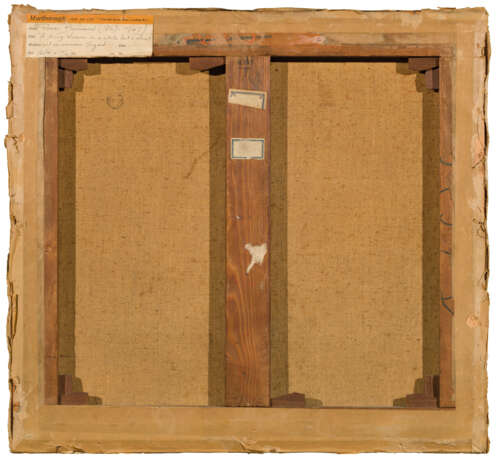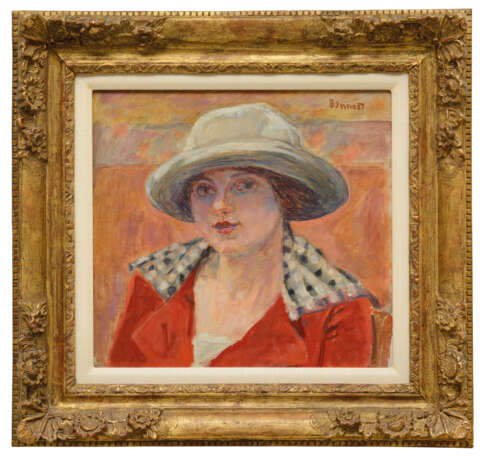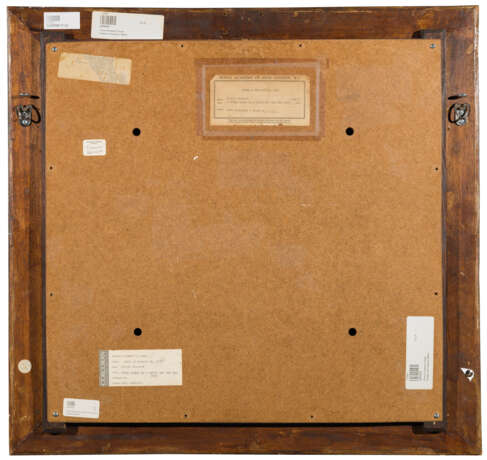ID 930356
Lot 136 | Pierre Bonnard (1867-1947)
Estimate value
€ 150 000 – 250 000
Jeune Femme au chapeau blanc ou Étude de tête
signé ‘Bonnard‘ (en haut à droite)
huile sur toile
42.1 x 45.1 cm.
Peint en 1912
signed ‘Bonnard‘ (upper right)
oil on canvas
16 5/8 x 17 3/4 in.
Painted in 1912
Provenance
Galerie Bernheim-Jeune, Paris (acquis auprès de l’artiste).
Lord Thomas Justice, Écosse (acquis auprès de celle-ci).
Alfred Vallotton (vers les années 1950).
Collection particulière.
Lady Jamieson, Londres (avant 1966 et jusqu’à au moins 1972).
Bentley Gallery, Scottsdale, Arizona.
Acquis auprès de celle-ci en 2002; vente, Sotheby's, New York, 7 novembre 2012, lot 132.
Acquis au cours de cette vente par le propriétaire actuel.
Literature
J. et H. Dauberville, Bonnard, Catalogue raisonné de l'œuvre peint, 1906-1919, Paris, 1968, vol. II, p. 449, no. 962 (illustré).
Exhibited
Paris, Grand Palais des Champs-Élysées, Salon d'Automne, 12ème Exposition, novembre-décembre 1919, p. 79, no. 181.
Londres, The Lefevre Gallery, School of Paris, Picasso and his contemporaries, mai-juin 1945, no. 5 (titré 'Tête de femme').
Zurich, Zürcher Kunstgesellschaft, Europäische Kunst 13. bis 20. Jahrhundert: aus Zürcher Sammlungen, juin-août 1950.
Londres, Royal Academy of Arts, Pierre Bonnard, janvier-mars 1966, p. 54, no. 144 (daté ‘vers 1920‘; titré ‘Marthe Bonnard‘).
Washington, D.C., Corcoran Gallery of Art, Summer's Lease, juin-août 1972.
Scottsdale, Bentley Gallery, Twentieth Century Masters, 2002.
(prêt long terme) Prague, National Gallery, Collections permanentes, Section "Modern Art", 2015-2018.
(prêt long terme) Prague, Kunsthalle Praha, juillet 2018-février 2023.
Post lot text
Jeune Femme au Chapeau Blanc possède toute l’intensité des couleurs, qui dès 1917, était devenue la signature de Bonnard. La toile toute entière est baignée par l’éclat chaud du soleil matinal. Une lumière jaune-orangée emplit l’arrière-plan derrière la jeune fille, enveloppée dans une robe rouge coquelicot. Légèrement cachée dans la demie-pénombre par son chapeau gris, son visage est également transformé par des touches irisées de pourpre, de lavande et de bleu céruléen.
Comme Dita Amory l’a écrit à propos de l'œuvre de Bonnard: « C’est par la couleur, non par la ligne, que les images s’emparaient de son imagination… Les couleurs de Bonnard incarnaient l'émergence, la rencontre et le passage des formes dans le monde transitoire, dont les éléments étaient transformés en formes et plans de rouge safran, de lumière dorée et d'ombres violettes.» (cité dans 'La présence des objets : la nature morte dans les dernières peintures et les intérieurs de Bonnard', in Pierre Bonnard, Les dernières natures mortes et les intérieurs, cat. exp., The Metropolitan Museum of Art, New York, 2004, p. 22-23).
Bonnard a développé une obsession précoce pour la couleur à travers son affiliation aux Nabis, un groupe d’artistes d’avant-garde qui s’est illustré dans le Paris de la fin du Siècle. Ces jeunes peintres, qui comptaient dans leurs rangs Maurice Denis, Edouard Vuillard et Paul Cerisier, étaient particulièrement inspirés par les figures post-impressionnistes tels que Paul Gauguin et Vincent Van Gogh. Les Nabis sont allés encore plus loin que leurs prédécesseurs en embrassant l’aspect bi-dimensionnel de la toile; de façon collective, ils cherchaient à réinventer la peinture française moderne à travers une radicalité des formes et des couleurs.
Bien que le groupe se soit dispersé dès 1917, Bonnard a continué à expérimenter les possibilités d’une pigmentation audacieuse et vive, avec des plans décoratifs richement ornés dans ses travaux plus tardifs.
Jeune Femme au Chapeau Blanc possesses all of the intensity of color that, by 1917, had become Bonnard’s signature. The warm glow of the morning sun has illuminated and colored the entire canvas. Yellow-orange light fills background behind the sitter who is swathed in a poppy-red gown. Slightly obscured in semi-darkness by her grey hat, her face is also transformed with iridescent strokes of lavender purple and cerulean blue. As Dita Amory has written of Bonnard’s work, “It was through colour, not line, that pictures took hold in his imagination…Bonnard’s colours came to embody the emerging, meeting, and passing of forms in the transient world, whose components he turned into shapes and planes of saffron red, gold light, and violet shadows” (quoted in ‘The Presence of Objects: Still Life in Bonnard’s Late Paintings’, in Pierre Bonnard, The Late Still Lifes and Interiors, exh. cat., The Metropolitan Museum of Art, New York, 2004, p. 22-23).
Bonnard developed an early obsession with colour through his affiliation with the Nabis, a group of avant-garde artists working in fin-de-siècle Paris. These young painters, who included amongst their ranks Maurice Denis, Édouard Vuillard and Paul Sérusier, were specifically inspired by the examples of Post-Impressionists like Paul Gauguin and Vincent van Gogh. The Nabis went even further than their predecessors in embracing the two-dimensionality of the canvas; collectively, they sought to reinvent modern French painting through radical color and forms.
Though the group had dispersed by 1917, Bonnard continued to experiment with the possibilities of bold, bright pigmentation and richly patterned, decorative surfaces in his later work.
| Artist: | Pierre Bonnard (1867 - 1947) |
|---|---|
| Applied technique: | Oil on canvas |
| Auction house category: | Paintings |
| Artist: | Pierre Bonnard (1867 - 1947) |
|---|---|
| Applied technique: | Oil on canvas |
| Auction house category: | Paintings |
| Address of auction |
CHRISTIE'S 9 Avenue Matignon 75008 Paris France | ||||||||||||||
|---|---|---|---|---|---|---|---|---|---|---|---|---|---|---|---|
| Preview |
| ||||||||||||||
| Phone | +33 (0)1 40 76 85 85 | ||||||||||||||
| Fax | +33 (0)1 40 76 85 86 | ||||||||||||||
| Conditions of purchase | Conditions of purchase | ||||||||||||||
| Shipping |
Postal service Courier service pickup by yourself | ||||||||||||||
| Payment methods |
Wire Transfer | ||||||||||||||
| Business hours | Business hours
|














